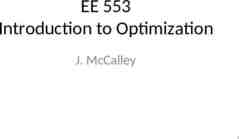INTRODUCTION TO BASIC DATA ANALYSIS AND INTERPRETATION FOR
19 Slides519.00 KB
INTRODUCTION TO BASIC DATA ANALYSIS AND INTERPRETATION FOR HEALTH PROGRAMS
Training Objectives To improve understanding of statistical and monitoring and evaluation (M&E) concepts in data analysis To build skills in basic data analysis, including setting targets and calculating program coverage, and service utilization and retention To enhance skills in data interpretation
Training Overview Training introduction Module 1: Data analysis key concepts Module 2: Basic analyses Module 3: Data presentation & interpretation Review of key themes
Introductions
Training Introduction
Training Introduction: Learning Objectives Understand the importance of improving data-informed decision making Understand the role of monitoring and evaluation (M&E) data in decision making Understand the importance of data analysis and interpretation
“ without information, things are done arbitrarily and one becomes unsure of whether a policy or program will fail or succeed. If we allow our policies to be guided by empirical facts and data, there will be a noticeable change in the impact of what we do.” National-level Policymaker, Nigeria
Why Improve Data-informed Decision Making? HIV epidemic Resurgence of TB Continued prevalence of malaria Pockets of stalled fertility decline Population burden Shortage of health care workers
Context Pressing need to develop health policies, strategies, and interventions
Monitoring and Evaluation Track changes in program performance over time Monitoring Attribute program outcomes to their causes Evaluation
Data Data sources Service delivery statistics Census Surveys, evaluations, research studies Sentinel surveillance Budget information Data vs. information unsynthesized vs. synthesized
Purposes of Monitoring and Evaluation Determine whether a plan or program is on schedule with planned activities Assess whether a policy, plan, or program has produced desired impacts Generate knowledge: Identify programmatic gaps, factors that influence health outcomes, etc. Inform policy, planning, or program decisions
M&E Is Not an Enemy Policymakers, program managers, and M&E/strategic information specialists can be partners Strong decision making and management rely on high-quality M&E / strategic information Data quality is linked to data use
Monitoring and Evaluation allows . data-based decisions, which lead to better health programs and better health outcomes
Group Participation Who analyzes and interprets data in your organization?
We can use information to Inform policies and plans Raise additional resources Strengthen programs and improve results Ensure accountability and reporting Improve quality of services provided Contribute to global lessons learned
“Making Data Speak” in Thailand Need: Strengthen commitment of policymakers to HIV prevention Data: Behavioral and epidemiological data Response: Analyzed data with Asian Epidemic Model and GOALS model Determined responses and resources needed Communicated data to stakeholders Decision/Action: Successfully emphasized prevention agenda in national strategic plan and developed an operational plan to guide prevention programming
Using NNRIMS Data to Inform Resource Allocation Need: Strengthen monitoring of HIV/AIDS service delivery Data: HIV service delivery indicators Response: Development of NNRIMS, a routine information system Quarterly reports summarizing data prepared for and reviewed by LGA managers & decision makers Decision/Action: Chairman procured 480 HIV test kits, enabling more people to get tested in Doma
Key Messages Decisions based on evidence lead to better health outcomes We all have a role in M&E – partners in progress High-quality information is needed for decision making at policy, planning, and program levels Purpose of M&E is not just to produce more information but to inform action
























